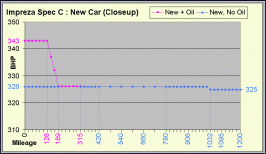- 971

- Sunny Devon
I have always wanted to start a thread saying that I have searched and found nothing, but the truth is that I found at least a dozen threads full of random musings, unsubstantiated rumours, incomplete data and even misinformation but very little reliable fact or reproducible data. So now I present to you my detailed findings.
PREPERATION
To assist in obtaining reliable figures with minimal rounding errors I required a high powered vehicle, and the Nissan R390 Race car seemed perfect with exactly 800BHP (actually PS, but that is a topic for another thread) at the garage list screen. A used version was also available as one of the Black Beauties, so I had a minimum power figure to work towards.
I took a new, unmodified R390 and proceeded directly to the test track at the driving park. This car was exactly as it arrived from the dealership - stock tyres, stock gear ratios, even stock oil. I selected Free run, and handed the keys to B-spec Bob instructing him to push hard. I exited the race as soon as he passed under the start/finish line and returned to view the car in my garage. The odometer read 1.2 miles. I then returned to the test track and repeated the run taking the odometer total to 2.5 miles. After another two runs the odometer was reading exactly 5.0 miles, so I concluded that a free run at the test track has a 1.25 mile run-up before the start line.
The test track is advertised as being 6.43 miles in length. A quick session in excel suggested that 1.25 miles run-up + 37 laps + 1350 metres would equal 240 miles - a nice round number. However in practise this turned out to be incorrect. The odometer reading was over by 1.8 miles!
A few more tests, and a little more time in excel and I came up with;
1.25 miles run-up + 46 laps (@ 6.48 miles) + 1050 metres equals 300 miles - another nice round number.
It now occurred to me that I did not know how hard the engine was working, so I took the car for a few laps in A-spec. I found that the car was nudging against the 7000rpm red line for most of the lap with a top speed of 229mph, and there was a ~7400rpm rev limiter. This seemed perfect as it meant the car was running on a knife edge with a reasonable red band before the fuel cutoff.
INITIAL TEST
1. New (Stock) Car Without Oil Change
After resetting the console to return the car to 0 miles I returned to the test track. Again I selected Free run, and again B-spec Bob was given the keys and told to push hard. I then left him to run for exactly 300 miles as earlier calculated. At the end of the run I returned to the car view at the garage to check the odometer before selecting change car as a quick way to save progress. This took me back to the garage list screen where I noted the power figure and entered the data into excel before sending Bob off again for the next 300 miles. Rinse and repeat forty times until the odometer reads 12,000 miles.
Sometimes at the end of a run the odometer would read over or under by 0.1 miles, and occasionally by 0.2 miles. If this occurred I would adjust the length of the following run by a hundred or so metres to return the reading to exact numbers. If the reading was over by 0.3 miles or more (as would happen if I was not paying attention), then I would reset the console and repeat the last run. This kept my mileage readings correct to within 0.1% - about as accurate as the power figures where the margin of error due to rounding is +/- 0.5 BHP.
A graph of the results (blue line) was plotted, and the car returned to the test track overnight in the capable hands of Bob to ensure no additional power was lost.
SUBSEQUENT TESTS
2. Used Car With Fresh Oil.
A used (Black) R390 was obtained and the mileage increased to 24,000 miles. The oil was then changed and this car handed over to Bob who again ran multiple sessions of 300 miles. 25 data points were recorded taking the mileage up to 31,500 and a graph plotted (purple line).
3. New Car With Fresh Oil.
A second new R390 was bought, the oil changed and the experiment repeated. 20 data points were recorded taking the mileage to 6000 and a graph plotted (pink line).
4. New Car With Regular Oil Changes.
Another new R390 was obtained and the oil changed. After each 300 mile session the oil was again changed before the data was collected. 35 data points were recorded and a graph plotted (orange line).
RESULTS
A table containing 120 data points was collected but not presented as this post is getting long enough already. A graph was plotted, and this is shown below. The data table can be supplied if enough people request it, but it is really not that interesting.

ANALYSIS
Although four tests were carried out, only three lines stand out.
The orange and purple lines display two different types of power loss with the blue line combining them. A third type of power loss is also signified by the pink spike.
The orange line represents power lost due to engine wear. This begins somewhere between 600 and 900 miles - some undocumented testing in steps of 20 miles narrows this down to somewhere between 780 and 800 miles. It follows an almost but not quite straight line, with the rate of power loss lessening towards the end. A final figure of 798BHP is observed at 7500 miles, equating to a power loss of exactly 5% from 840BHP.
The purple line represents power lost due to dirty oil. This occurs suddenly between 3300 and 4500 miles, and is again exactly 5% (760BHP -> 722BHP)
The blue line combines these with a 5% drop from 800BHP to 760BHP for engine wear, and a further 5% drop from 760BHP to 722BHP for dirty oil. Note that this does not give a total drop of 10% as these losses are multiplied rather than added giving a total power loss of 9.75% from 800BHP.
Also, closer examination of the graph shows that the sudden drop due to dirty oil occurs earlier with the new car than it does with the used one, and maximum power loss occurs later in the unmaintained car that it does with the well maintained one.
The pink spike represents power loss (or gain) due to maintenance. An oil change gives a gain of 5% from 800BHP to 840BHP, but this is very short lived lasting for less than 300 miles. The power then returns to the original level of 800BHP before following the blue line exactly.
CONCLUSIONS
There is no difference between stock oil and GT Auto oil. Although an oil change seems to give you a 5% power boost, this is very short lived and is most likely down to the engine being in peak condition due to having just been serviced. The engine being more highly strung will rev more freely and possibly accelerate engine wear over time, but will quickly settle back down to stock power.
Engine wear reduces power permanantly by up to 5% depending on mileage. It begins within 800 miles and starts at a steady rate. The rate of wear lessens over time, and is noticeably slower after the sudden drop in power due to dirty oil. This suggests that when trying to wear a car out for increased A-spec points it may be beneficial to perform an oil change after the first 3000 miles.
Dirty oil reduces power by a further 5% and occurs suddenly. In this case it begins at around 3000 miles, but there is sufficient evidence to suggest that this can vary significantly depending on engine power and/or RPM.
The Nissan R390 Race car whilst perfect for this set of tests is a costly proposition. It will have to be exchanged for something more affordable in future tests.
ADDITIONAL WORK
A closer look at the power spikes due to fresh oil is already underway.
Further tests looking at the effects of engine revs, engine type (V8/rotary/boxer etc), aspiration type (NA/turbo/supercharged) and vehicle type (road/race/tuner/concept) are also planned, and Bob is currently running in circles around the test track in a VW Nardo Concept to get these underway. However, with the original (blue line) test requiring some 20 hours of Bob's time punctuated with regular stops for data collection, this may take some time.
PREPERATION
To assist in obtaining reliable figures with minimal rounding errors I required a high powered vehicle, and the Nissan R390 Race car seemed perfect with exactly 800BHP (actually PS, but that is a topic for another thread) at the garage list screen. A used version was also available as one of the Black Beauties, so I had a minimum power figure to work towards.
I took a new, unmodified R390 and proceeded directly to the test track at the driving park. This car was exactly as it arrived from the dealership - stock tyres, stock gear ratios, even stock oil. I selected Free run, and handed the keys to B-spec Bob instructing him to push hard. I exited the race as soon as he passed under the start/finish line and returned to view the car in my garage. The odometer read 1.2 miles. I then returned to the test track and repeated the run taking the odometer total to 2.5 miles. After another two runs the odometer was reading exactly 5.0 miles, so I concluded that a free run at the test track has a 1.25 mile run-up before the start line.
The test track is advertised as being 6.43 miles in length. A quick session in excel suggested that 1.25 miles run-up + 37 laps + 1350 metres would equal 240 miles - a nice round number. However in practise this turned out to be incorrect. The odometer reading was over by 1.8 miles!
A few more tests, and a little more time in excel and I came up with;
1.25 miles run-up + 46 laps (@ 6.48 miles) + 1050 metres equals 300 miles - another nice round number.
It now occurred to me that I did not know how hard the engine was working, so I took the car for a few laps in A-spec. I found that the car was nudging against the 7000rpm red line for most of the lap with a top speed of 229mph, and there was a ~7400rpm rev limiter. This seemed perfect as it meant the car was running on a knife edge with a reasonable red band before the fuel cutoff.
INITIAL TEST
1. New (Stock) Car Without Oil Change
After resetting the console to return the car to 0 miles I returned to the test track. Again I selected Free run, and again B-spec Bob was given the keys and told to push hard. I then left him to run for exactly 300 miles as earlier calculated. At the end of the run I returned to the car view at the garage to check the odometer before selecting change car as a quick way to save progress. This took me back to the garage list screen where I noted the power figure and entered the data into excel before sending Bob off again for the next 300 miles. Rinse and repeat forty times until the odometer reads 12,000 miles.
Sometimes at the end of a run the odometer would read over or under by 0.1 miles, and occasionally by 0.2 miles. If this occurred I would adjust the length of the following run by a hundred or so metres to return the reading to exact numbers. If the reading was over by 0.3 miles or more (as would happen if I was not paying attention), then I would reset the console and repeat the last run. This kept my mileage readings correct to within 0.1% - about as accurate as the power figures where the margin of error due to rounding is +/- 0.5 BHP.
A graph of the results (blue line) was plotted, and the car returned to the test track overnight in the capable hands of Bob to ensure no additional power was lost.
SUBSEQUENT TESTS
2. Used Car With Fresh Oil.
A used (Black) R390 was obtained and the mileage increased to 24,000 miles. The oil was then changed and this car handed over to Bob who again ran multiple sessions of 300 miles. 25 data points were recorded taking the mileage up to 31,500 and a graph plotted (purple line).
3. New Car With Fresh Oil.
A second new R390 was bought, the oil changed and the experiment repeated. 20 data points were recorded taking the mileage to 6000 and a graph plotted (pink line).
4. New Car With Regular Oil Changes.
Another new R390 was obtained and the oil changed. After each 300 mile session the oil was again changed before the data was collected. 35 data points were recorded and a graph plotted (orange line).
RESULTS
A table containing 120 data points was collected but not presented as this post is getting long enough already. A graph was plotted, and this is shown below. The data table can be supplied if enough people request it, but it is really not that interesting.

ANALYSIS
Although four tests were carried out, only three lines stand out.
The orange and purple lines display two different types of power loss with the blue line combining them. A third type of power loss is also signified by the pink spike.
The orange line represents power lost due to engine wear. This begins somewhere between 600 and 900 miles - some undocumented testing in steps of 20 miles narrows this down to somewhere between 780 and 800 miles. It follows an almost but not quite straight line, with the rate of power loss lessening towards the end. A final figure of 798BHP is observed at 7500 miles, equating to a power loss of exactly 5% from 840BHP.
The purple line represents power lost due to dirty oil. This occurs suddenly between 3300 and 4500 miles, and is again exactly 5% (760BHP -> 722BHP)
The blue line combines these with a 5% drop from 800BHP to 760BHP for engine wear, and a further 5% drop from 760BHP to 722BHP for dirty oil. Note that this does not give a total drop of 10% as these losses are multiplied rather than added giving a total power loss of 9.75% from 800BHP.
Also, closer examination of the graph shows that the sudden drop due to dirty oil occurs earlier with the new car than it does with the used one, and maximum power loss occurs later in the unmaintained car that it does with the well maintained one.
The pink spike represents power loss (or gain) due to maintenance. An oil change gives a gain of 5% from 800BHP to 840BHP, but this is very short lived lasting for less than 300 miles. The power then returns to the original level of 800BHP before following the blue line exactly.
CONCLUSIONS
There is no difference between stock oil and GT Auto oil. Although an oil change seems to give you a 5% power boost, this is very short lived and is most likely down to the engine being in peak condition due to having just been serviced. The engine being more highly strung will rev more freely and possibly accelerate engine wear over time, but will quickly settle back down to stock power.
Engine wear reduces power permanantly by up to 5% depending on mileage. It begins within 800 miles and starts at a steady rate. The rate of wear lessens over time, and is noticeably slower after the sudden drop in power due to dirty oil. This suggests that when trying to wear a car out for increased A-spec points it may be beneficial to perform an oil change after the first 3000 miles.
Dirty oil reduces power by a further 5% and occurs suddenly. In this case it begins at around 3000 miles, but there is sufficient evidence to suggest that this can vary significantly depending on engine power and/or RPM.
The Nissan R390 Race car whilst perfect for this set of tests is a costly proposition. It will have to be exchanged for something more affordable in future tests.
ADDITIONAL WORK
A closer look at the power spikes due to fresh oil is already underway.
Further tests looking at the effects of engine revs, engine type (V8/rotary/boxer etc), aspiration type (NA/turbo/supercharged) and vehicle type (road/race/tuner/concept) are also planned, and Bob is currently running in circles around the test track in a VW Nardo Concept to get these underway. However, with the original (blue line) test requiring some 20 hours of Bob's time punctuated with regular stops for data collection, this may take some time.


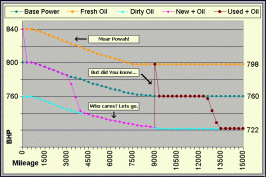
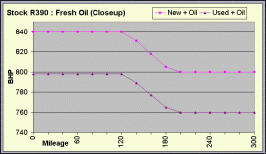
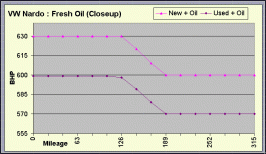
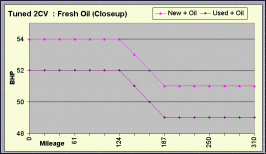

 This is one that surely woulda deserved some +rep from all of us.
This is one that surely woulda deserved some +rep from all of us. 

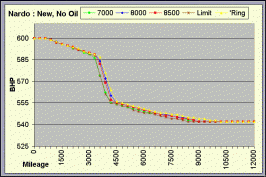
 That was the Pontiac GTO (Monaro shape). Stock, it was 260Kw....after around 300km of racing (through the stars and stripes series), it went up to 262Kw. However, I notice from your second study graph that you didn't get a power increase from the Nardo.
That was the Pontiac GTO (Monaro shape). Stock, it was 260Kw....after around 300km of racing (through the stars and stripes series), it went up to 262Kw. However, I notice from your second study graph that you didn't get a power increase from the Nardo. 

